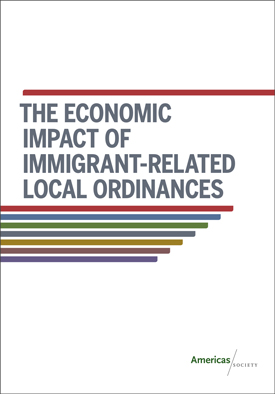The Economic Impact of Immigrant-Related Local Ordinances
The Economic Impact of Immigrant-Related Local Ordinances
This Americas Society white paper provides the first comparative look at the average economic effects of how restrictive versus non-restrictive immigration-related city ordinances affect a business environment. Using statistical analysis, the report demonstrates that non-restrictive city ordinances are better for an overall jobs environment.
 This Americas Society white paper provides the first comparative look at the average economic effects of how restrictive versus non-restrictive immigration-related city ordinances affect a city’s business environment. In a context of high unemployment and lackluster business growth, along with rising anxieties regarding immigration in the United States, we believe it essential to provide a better understanding of how policies that seek to restrict immigration and those that support more flexible approaches affect the economies of communities across the country.
This Americas Society white paper provides the first comparative look at the average economic effects of how restrictive versus non-restrictive immigration-related city ordinances affect a city’s business environment. In a context of high unemployment and lackluster business growth, along with rising anxieties regarding immigration in the United States, we believe it essential to provide a better understanding of how policies that seek to restrict immigration and those that support more flexible approaches affect the economies of communities across the country.
The Economic Impact of Immigrant-Related Local Ordinances finds that restrictive ordinances have a negative impact on the number of employees in a city when compared to cities that instead chose to enact non-restrictive ordinances. In fact, an average city with a restrictive ordinance has 0.18 times fewer expected number of employees than its non-restrictive counterpart. This means that beyond anecdotal evidence of how restrictive immigration laws are creating productivity losses in places like Alabama and Georgia, this paper shows—in a statistically significant manner—that non-restrictive city ordinances are better for a city’s overall jobs environment than restrictive ordinances.
- Download the PDF of the white paper.
- Access an appendix of sources for city ordinances.
- Learn more about the Hispanic Integration Hub.
- Learn more about AS/COA's Hispanic Integration and Immigration Working Group.
The paper looks at 53 cities that officially implemented either restrictive (housing, employment, 287(g), or English-only) or non-restrictive (sanctuary city) ordinances between 2006 and 2008 and that were still being enforced through 2009. Isolating for a number of outside variables, we then compare how the business environment (measured as number of businesses and number of employees) was in those cities at passage and in 2009. State policies—especially those receiving recent national attention—are not considered due to the period of the study. Further, while one type of ordinance was not observed to affect business closure more than the other, the decline in the number of employees in restrictive cities could lead to the long-term reduction in business productivity and the decline in worker consumption in the local economy; thus, increasing the likelihood of business closure.
This report was made possible with support from the Rockefeller Brothers Fund.
About the Authors
Jason Marczak, AS/COA director of policy, leads the Hispanic Integration and Immigration Initiative. Jerónimo Cortina, assistant professor of political science at the University of Houston, is the senior researcher for this white paper and prepared the original draft of the research with research associate George Hawley; they were assisted by research assistants Aaron Diamond and Chris Nicholson. Richard André, AS/COA policy associate, helps to oversee Americas Society’s immigration work, and Alexandra Délano, assistant professor at The New School University, is the senior adviser for this project. Lina Salazar is the special assistant for this project.
About the Hispanic Integration and Immigration Initiative
Americas Society (AS), leveraging the relationship with its affiliate organization Council of the Americas (COA), promotes dialogue and information sharing among the private sector, public sector and community groups to advance Latino integration in the U.S., with a focus on the immigrant population. The Hispanic Integration and Immigration Initiative supports the further integration of immigrant workers into businesses and local communities while creating a more mobilized and visible business sector with regard to issues of immigrant integration.
.








